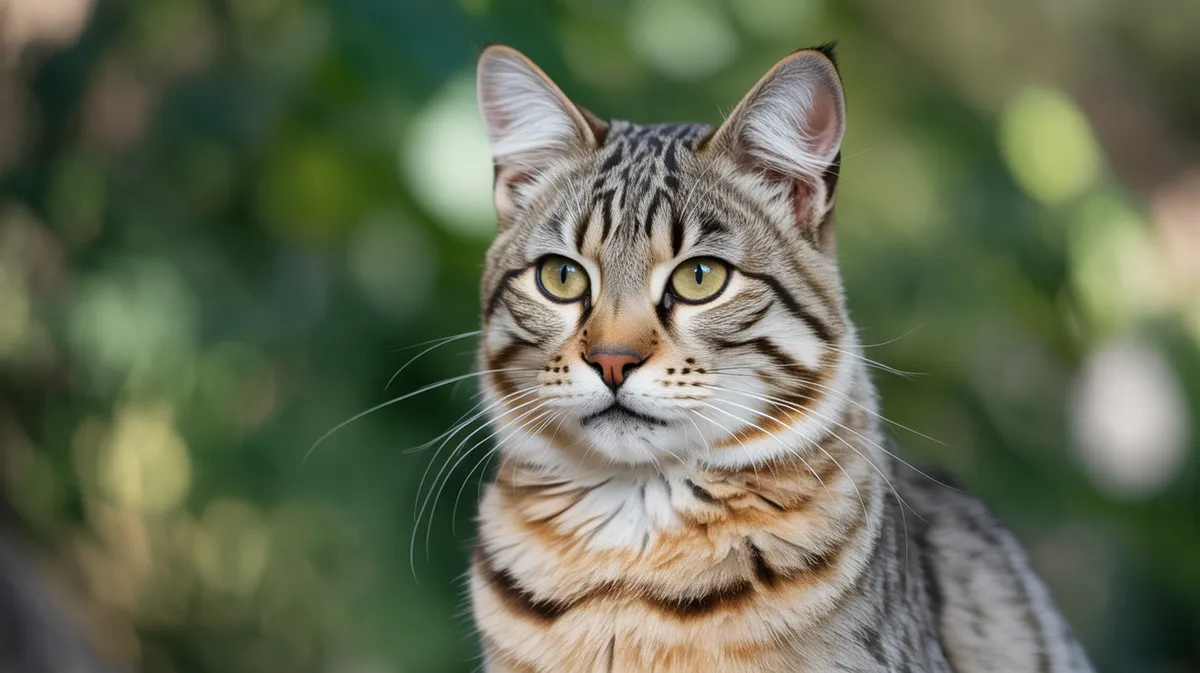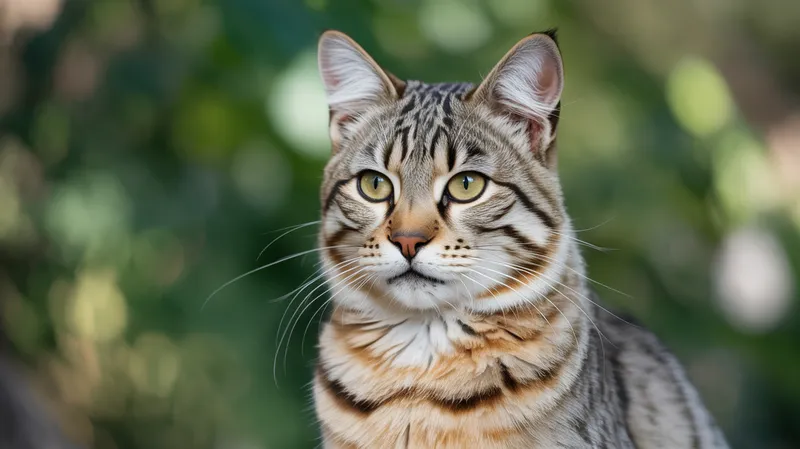
Kinkalow Cat
Felis catus

Meet the Kinkalow Cat
The Kinkalow is a rare, designer breed of domestic cat developed by crossing the Munchkin and the American Curl. This small, playful feline is distinguished by its very short legs and distinctive curled-back ears, giving it a unique and endearing appearance. Kinkalows are known for their friendly, affectionate personalities and high energy, often displaying a kitten-like demeanor well into adulthood. Due to their rarity and hybrid status, Kinkalows are primarily found as companion animals in select homes and catteries.
Classification
Mammal
Habitat
Domestic/Home
Diet
Carnivore
Lifespan
12-15 years
Conservation
Not Evaluated
Weight
1.8–3.2 kg (4–7 lbs)
📖Fascinating Facts
Short Legs
Kinkalows have notably short legs due to their Munchkin ancestry, giving them a unique and adorable stature.
Curled Ears
Their curled-back ears come from the American Curl parent, and the degree of curl can vary among individuals.
Indoor Companions
Kinkalows are best suited to indoor living due to their body structure and rarity, making them ideal house pets.
📋Detailed Description
The Kinkalow cat is a diminutive and highly distinctive breed, notable for its combination of two unique genetic traits: the shortened limbs of the Munchkin and the backward-curling ears of the American Curl. Adult Kinkalows typically weigh between 2.2 and 4.5 kg (5–10 lbs) and stand low to the ground, with legs approximately 5–8 cm (2–3 inches) shorter than typical domestic cats. Their bodies are compact yet muscular, supporting agile movement despite their stature. The breed’s ears are set wide apart and curl backward in a graceful arc, a result of a dominant gene mutation affecting cartilage. Kinkalows have a plush, soft coat that may be short or semi-long, displaying a wide variety of colors and patterns. Their eyes are large, expressive, and almond-shaped, contributing to their perpetually youthful appearance. Behaviorally, Kinkalows are lively, inquisitive, and highly social, often forming strong attachments to their human companions and other pets. They are known for their playful antics, including chasing, climbing, and interactive games, and tend to retain kitten-like energy well into adulthood. Despite their small size, Kinkalows are robust and generally healthy, though their unique morphology requires careful breeding to avoid skeletal issues. Their rarity and hybrid status mean they are primarily found in select catteries and as cherished pets in dedicated homes.
💡 Did you know?
Kinkalow kittens can be born with either straight or curled ears, but only those with curled ears are considered true Kinkalows by breed standards.
🔬Research & Sources
🎭Behavior & Social Structure
Kinkalow cats are highly active and intelligent, requiring regular mental and physical stimulation. They exhibit pronounced playfulness, often engaging in fetch, puzzle toys, and interactive play with humans. Their shortened legs do not significantly hinder their agility; they are adept at climbing and leaping, though their vertical jump is somewhat reduced compared to long-legged breeds. Kinkalows are social and thrive in multi-pet households, displaying amicable behavior toward both cats and dogs. They communicate through a range of vocalizations, purring, and body language, often seeking attention and companionship. While not typically aggressive, they may display territorial behaviors if not properly socialized. Feeding behavior is consistent with obligate carnivores, preferring high-protein diets and exhibiting hunting instincts through play. Daily routines include periods of intense activity interspersed with long naps, often in elevated or cozy locations.
👶Reproduction & Life Cycle
Kinkalow cats reach sexual maturity between 6 and 10 months of age. Breeding is carefully managed to avoid health complications associated with their genetic traits; typically, a Munchkin is crossed with an American Curl to produce first-generation Kinkalows. The gestation period averages 63–65 days, with litters ranging from 2 to 6 kittens. Not all kittens inherit both the short-legged and curled-ear traits; only those displaying both are considered true Kinkalows. Parental care is provided primarily by the mother, who nurses and grooms the kittens for 8–10 weeks. Breeders monitor for congenital issues such as lordosis (spinal curvature) or osteochondrodysplasia (bone/cartilage disorders), though these are less common in Kinkalows than in some other dwarf breeds. There is no specific breeding season, as domestic cats can reproduce year-round under suitable conditions.
🛡️Adaptations & Survival
The Kinkalow’s most notable adaptations are its short legs and curled ears, both resulting from specific genetic mutations. The shortened limbs, due to an autosomal dominant gene (Munchkin gene), confer a unique low-slung gait and may aid in maneuvering through tight spaces, though they slightly limit jumping height. The curled ears, caused by a mutation in the cartilage gene (Curl gene), serve no known functional purpose but are a hallmark of the breed. Behaviorally, Kinkalows compensate for their stature with agility, strong hindquarters, and an ability to climb and play energetically. Their sociable nature and adaptability to indoor environments make them well-suited as companion animals, thriving in human-centric habitats.
📚Research Sources
🎨Cultural Significance
The Kinkalow cat is a product of modern selective breeding and does not have a historical or mythological presence. Its cultural significance lies in its status as a rare and visually striking companion animal, often featured in social media and pet enthusiast communities. The breed exemplifies contemporary trends in designer pets, reflecting human fascination with novel physical traits. While not traditionally used for any specific purpose beyond companionship, Kinkalows have contributed to discussions about ethical breeding and animal welfare in the context of hybrid and dwarf breeds.
🔬Recent Research & Discoveries
Recent studies on the Kinkalow and similar breeds focus on the genetic mechanisms underlying limb shortening (Munchkin gene, FGF4 retrogene) and ear cartilage mutations. Veterinary research emphasizes the importance of screening for musculoskeletal disorders and monitoring long-term health outcomes in hybrid breeds. Ongoing debates in the scientific and veterinary communities address the ethics of breeding for extreme physical traits and the potential welfare implications. No peer-reviewed studies have specifically targeted the Kinkalow, but related research on Munchkin and American Curl genetics provides valuable insights. Breed clubs and registries are collecting health and temperament data to inform best practices for breeding and care.
🎥Wildlife Videos

These Are All Cat Breeds That Currently Exist
PREVIOUS VIDEO: https://youtu.be/NiwJGDi5R9s Stay tuned in our Community: ...
ViralBe

Top 5 Most Dangerous Cats In The World You will Not See | دنیا میں 5 حطرناک بلیاں آپ نے نہیں دیکھا
Top 5 Most Dangerous Cats In The World You will Not See | دنیا میں 5 حطرناک بلیاں آپ نے نہیں دیکھا Dunia ka 5 Khaas Cats All ...
Home Tech HD

Interesting Facts About Cats | Information About Cats | Interesting About Cats | Hidden Secrets|cats
Interesting Facts About Cats | Information About Cats | Interesting About Cats | Hidden Secrets A cat is a carnivorous mammal.
Apna Tube

Cats 101 : Top 10 Cutest Cats in the World
Use coupon code "KITTENLIFE" to get 20% OFF The Best Cat Collars Available here : https://www.bemixpets.com ( Use coupon ...
Kitten Life

LaPerm Cat VS. American Curl Cat
Use coupon code "KITTENLIFE" to get 20% OFF The Best Cat Collars Available here : https://www.bemixpets.com ( Use coupon ...
Kitten Life
🌍Habitat Information
The Kinkalow Cat typically inhabits Domestic/Home environments. Kinkalow Cats have adapted to their environments with specialized features and behaviors.
Primary Habitat:
Domestic/Home
More detailed habitat information will be available soon.
🛡️Conservation Status
The Kinkalow Cat is currently classified as Not Evaluated. Conservation efforts are crucial for preserving this species for future generations.
Common Threats:
- 🏠Habitat loss and fragmentation
- 🌡️Climate change impacts
- 🎯Hunting and poaching
- 🏭Human-wildlife conflict
⚠️Threats & Conservation Challenges
As a designer breed, the Kinkalow faces challenges related to genetic diversity and responsible breeding practices. Inbreeding and improper selection can increase the risk of hereditary health issues, particularly skeletal and cartilage disorders. The breed’s rarity means there is limited data on population trends, but demand for unique physical traits can incentivize unethical breeding. Kinkalows are not recognized by major cat registries such as the Cat Fanciers’ Association (CFA) or The International Cat Association (TICA), which limits standardized health monitoring. There are no significant threats from habitat loss or predation, as Kinkalows are exclusively domestic. However, their dependence on human care makes them vulnerable to neglect or abandonment if owners are unprepared for their needs.
🔬Scientific Classification
Scientific Name
Felis catus
Classification Hierarchy
🔍 About Taxonomic Classification
Taxonomic classification is a hierarchical system used by scientists to classify and organize living organisms based on shared characteristics and evolutionary relationships.
The system moves from broad categories (Kingdom) to increasingly specific ones, with each animal's scientific name typically consisting of its Genus and species.
📝Community Notes
Share your observations and insights about the Kinkalow Cat with our community of wildlife enthusiasts.
Join Our Community
Sign in to share your observations and connect with fellow wildlife enthusiasts.
Sign In to ContributeNo community notes yet
Be the first to share your observations about the Kinkalow Cat!
Explore Kinkalow Cat
Select a tab above to learn more about this amazing animal.
📸Photo Gallery
No photos available for this animal yet.
🌟Discover More Wildlife
Continue your journey of discovery with more fascinating animals from our database
